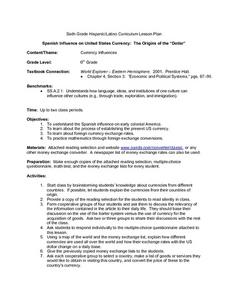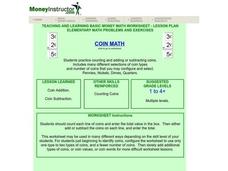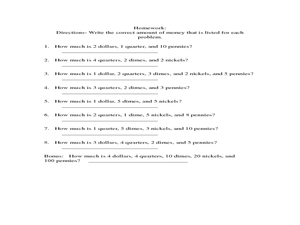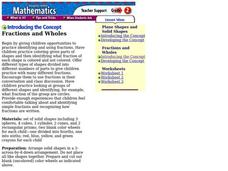Charleston School District
Solving Systems with Elimination
Can you handle one more method? It just might be your favorite! Building on the skills learned in the previous lessons in the series, scholars now learn the elimination method. The video examines problems of varying difficulty.
Curated OER
Money Math: Lessons for Life
Students develop a budget for a college student using all of the influences that the student would have. In this budgeting lesson plan, students use real life examples to create a budget spreadsheet. Students read and study sample...
Curated OER
My Money
Learners identify and interpret the relationships between various components of currency, discusses the uses of money, and provides advanced lessons on making change. They also identify the various ways that money is used and how to use...
Curated OER
Spanish Influence on United States Currency: The Origins of the "Dollar"
Sixth graders research the Spanish influence on early colonial America and the process of establishing the present U.S. currency. They read and discuss an informational handout in small groups, and take a short quiz. Students then...
Curated OER
Grocery Store Math- Home/School Activity
In this home/school consumer math activity, students examine ways to save money at the grocery store. They work with a family partner to write a menu and write a shopping list. They shop for the items noting the prices and using a...
Curated OER
Quarter, Nickel, Dime....
An engaging game called, "Quarter, Nickel, and Dime" is presented in this math lesson. Players are given an envelope with slips of paper that represent the three coins. In pairs, they play the game 18 times, and the whole class charts...
Mathalicious
Pic Me!
Finally! Math and Instagram have come together to discuss the correlation between likes and followers. High schoolers can't help but want to discover what makes one account more popular than another by developing a line of best fit and...
PricewaterhouseCoopers
Credit and Debt: Decisions, Decisions...
Borrowing money seems like a great idea until you are in over your head. High schoolers learn the benefits and risks associated with credit and how to be a responsible borrower. More than just credit cards, they learn trustworthiness is...
Curated OER
Hands On: Add and Subtract Money Amounts
In this consumer math worksheet, students use a table and play money to solve each of 8 money story problems. Students will use a price list provided.
Curated OER
Counting Coins
Students practice counting and adding or subtracting coins. The lesson includes many different selections of coin types and number of coins that you may configure and select. Pennies, Nickels, Dimes, Quarters are the coins used.
Curated OER
Teaching Money
Students identify the coins and bills used in the United States. They write the amounts of each bill and coin and practicing counting different amounts. They follow a demonstration about how to count money as well.
Curated OER
How Much Money Do You Have?
Second graders are given 8 world problems dealing with an assortment of coins. In this money instructional activity, 2nd graders determine the answers to each problem with 100% accuracy. Students complete a worksheet that is graded.
Curated OER
Coins: Names and Value
Students read the story Benny's Pennies and play a matching game where they match the coin to it's value. In this coins lesson plan, students use the SMART Board to view coins.
Curated OER
Spending Money
First graders practice adding monetary values. In this money lesson, 1st graders discuss fair trades and then use coin values to purchase items from a class store. A video titled "Blossom and Snappy Go to the Bank, Part Two".
Curated OER
Revolutionary Money
Examine paper money from the American revolution! Historians study the paper bills and discuss the history of money. How has money changed over the times? Activities are included.
Curated OER
Money Matters - Teaching About Economics
The right money lesson plans can teach students about economics in an engaging way.
Curated OER
Money in India: Comparison Shopping
Students are exposed to a monetary system different from their own. They learn to exchange currencies between two monetary systems. Practice the necessary mathematical functions to find comparison. Compare prices of items sold in India...
EngageNY
Writing and Graphing Inequalities in Real-World Problems
Inequalities: when one solution just doesn't suffice. Individuals learn to write inequalities in real-world contexts and graph solution sets on the number line. All inequalities in the lesson are of the form x < c or x < c.
EngageNY
From Ratios to Rates
Rate ratios with unit rates and rate units. Pupils take ratios and determine their associated rates and unit rates. The scholars identify the different aspects of rates, the unit rate, and the rate unit. The lesson is the 16th in a...
EngageNY
Informally Fitting a Line
Discover how trend lines can be useful in understanding relationships between variables with a lesson that covers how to informally fit a trend line to model a relationship given in a scatter plot. Scholars use the trend line to make...
Federal Reserve Bank
Expense Tracking
Where does all your money go? Individuals keep a record of the money they spend over the course of 30 days. They then categorize where they are spending their money and write an essay detailing their findings.
Visa
Dream Big: Money and Goals
Whether their objective is independent living, going to college, or buying a car, pupils will participate in discussions and complete worksheets to gain an understanding of how short- and long-term goals play a large role in helping...
EngageNY
The Mathematics Behind a Structured Savings Plan
Make your money work for you. Future economists learn how to apply sigma notation and how to calculate the sum of a finite geometric series. The skill is essential in determining the future value of a structured savings plan with...
Curated OER
Fractions and Wholes
Lower elementary learners recognize solid shapes distributed for making fractions. Each individual uses a wheel and determine which part of a fraction is missing. This is a great lesson for your visual learners!
Other popular searches
- Money Math Lessons
- Counting Money Math Lessons
- Autism Money Math Lessons
- Shopping Money Math Lessons
- Math Lessons With Money
- Math Lessons on Money
- Money Math Lessons for Life

























